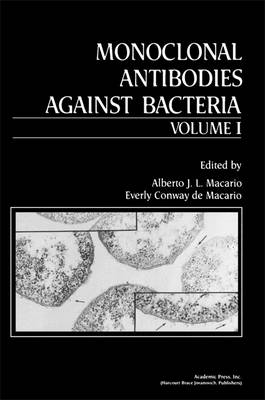
Monoclonal Antibodies against Bacteria
Academic Press Inc (Verlag)
978-0-12-463001-7 (ISBN)
- Titel ist leider vergriffen;
keine Neuauflage - Artikel merken
Contributors
Preface
Introduction: Monoclonal Antibodies against Bacteria for Medicine, Dentistry, Veterinary Sciences, Biotechnology, and Industry—An Overview
Contents of Volume II
1 Monoclonal Antibodies against Gonococcal Pili: Uses in the Analysis of Gonococcal Immunochemistry and Virulence
I. Introduction
II. Background
III. Results and Discussion
IV. Conclusions
V. Prospects for the Future
VI. Summary
References
2 Monoclonal Antibodies against Group B Streptococcus
I. Introduction
II. Background
III. Methods and Results
IV. Conclusions
V. Summary
References
3 Studies with Monoclonal Antibodies to Mycobacteria
I. Introduction
II. Results and Discussion
III. Conclusions and Prospects for the Future
IV. Summary
References
4 Monoclonal Antibodies to Characterize the Antigenic Heterogeneity of Bacteroides intermedius
I. Introduction
II. Background
III. Results and Discussion
IV. Conclusions
V. Prospects for the Future
VI. Summary
References
5 Monoclonal Antibodies against Legionella pneumophila Serogroup 1 Antigens: Characterization and Their Potential Applications
I. Introduction
II. Background
III. Results and Discussion
IV. Conclusions
V. Prospects for the Future
VI. Summary
References
6 Monoclonal Antibodies Specific for the O-Antigen of Shigella flexneri and Shigella sonnei: Immunochemical Characterization and Clinical Usefulness
I. Introduction
II. Background
III. Results and Discussion
IV. Conclusions and Prospects for the Future
V. Summary
References
7 Monoclonal Antibodies against Group- and Type-Specific Antigens of Vibrio cholerae O:1
I. Introduction
II. Background
III. Results and Discussion
IV. Conclusions
V. Prospects for the Future
VI. Summary
References
8 Monoclonal Antibodies against Tetanus Toxin and Tetanus Toxoid
I. Introduction
II. Background
III. Methods for Generation of Monoclonal Antibodies
IV. Results and Discussion
V. Prospects for the Future
VI. Summary
References
9 Human Monoclonal Antibodies for Prophylaxis and Therapy of Bacterial Infections
I. Introduction
II. Background
III. Results and Discussion
IV. Conclusions and Future Prospects
V. Summary
References
10 Monoclonal T Cells and T-Cell Hybridomas with Antibacterial Activity
I. Introduction
II. Background
III. Results and Discussion
IV. Conclusions and Prospects for the Future
V. Summary
References
11 A Preview of the Uses of Monoclonal Antibodies against Methanogens in Fermentation Biotechnology: Significance for Public Health
I. Introduction
II. Background
III. Results and Discussion
IV. Conclusions
V. Prospects for the Future
VI. Summary
References
12 An International Hybridoma Data Bank: Aims, Structure, Function
I. Introduction
II. Background of Sponsoring Organizations
III. Operations Framework
IV. System Design
V. Funding and Support
VI. Prospects for the Future
VII. Conclusions
VIII. Summary
References
Index
| Erscheint lt. Verlag | 1.1.1986 |
|---|---|
| Verlagsort | San Diego |
| Sprache | englisch |
| Gewicht | 660 g |
| Themenwelt | Medizin / Pharmazie ► Medizinische Fachgebiete ► Mikrobiologie / Infektologie / Reisemedizin |
| Studium ► Querschnittsbereiche ► Infektiologie / Immunologie | |
| ISBN-10 | 0-12-463001-4 / 0124630014 |
| ISBN-13 | 978-0-12-463001-7 / 9780124630017 |
| Zustand | Neuware |
| Haben Sie eine Frage zum Produkt? |
aus dem Bereich


